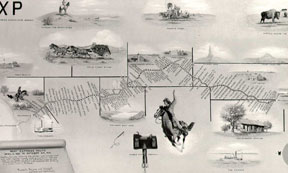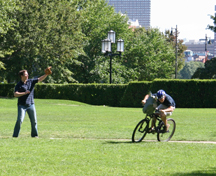Home > Experiments > The demise of the Pony Express
Demise of the Pony Express: idea feasibility testing
September 2006

Click on each picture to see a large version.
In the response to the Gold Rush in the mid-1800s, the Pony Express was developed as an alternative mail service crossing the North American continent.
Using mounted riders, the founders of the Pony Express hoped to create a conduit for mail that was faster and more reliable than stagecoaches. |
|
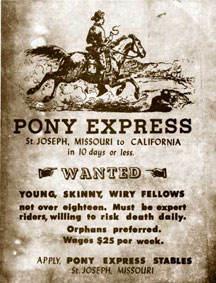 |
The Pony Express only operated for a year and a half—from April 1860 to November 1861—even though it offered excellent wages and employee benefits.
The demise of the Pony Express is commonly attributed to the telegraph. The completion of the telegraph network and the termination of the Express occurred within a one-month period.
|
But there is another, lesser-known myth (unknown, actually) that a different technology was the nail in the Express’s coffin.
Letters were placed inside baseballs and thrown along a relay of ball carriers.
This new system was faster than using horses, and the ball carriers were less tired than the Pony Express riders, who had to endure long days in the saddle. All a ball carrier had to do was hang out and play catch. |
|
 |
Can a ball relay beat a horse? 2.009ers applied their estimation skills and rapid idea testing processes to find an answer.
|
Some numbers: the estimation
Given paper, pencils, and 5 minutes, the class of 100 students was charged with completing a quick back-of-the-envelope technical feasibility assessment of the myth.
Here is how the course instructor approached the problem.
Assuming an average ball carrier can throw a 40 mph ball 100 feet and catch-throw in 2 seconds, the ball relay is expected to be a blazing 20 mph, roughly 2X the Express’s average speed of 10 mph. However, just one drop in 10 might allow the express to win. |
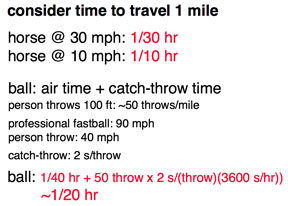
|
With strong-armed ball carriers, the relay might even be competitive with a horse running at 30 mph!
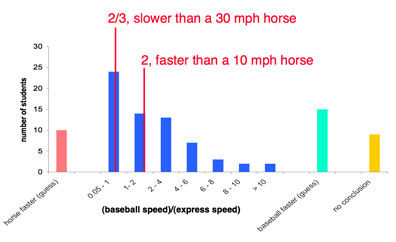
|
Not all students agreed. Some thought the ball relay would be much slower (up to 20X slower), and a few thought it would be much faster (up to 10X faster)!
A confirmation sketch model, or validation experiment, was in order. |
Resolving the debate
The proving ground was MIT’s Killian Court.
Watch the video to see the action and then read on for more details.
(video also available as:
.mov 1.3 MB, .mov 4.5 MB, full resolution dv)
|
Don't see the video?
Get Flash player first.
|
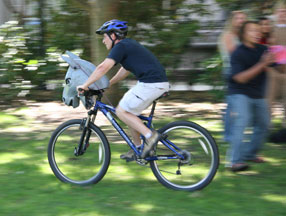 |
After a 10-minute warm-up and practice session, the validation experiment was completed under the watchful eye of an impartial cowboy.
The GPS-equipped Pony Express rider was Tom, the teaching assistant, on his horse-headed mountain bike. |
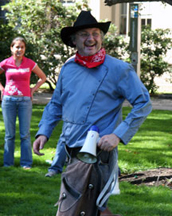
|
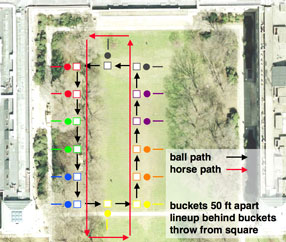
|
14 ball-throwing stations, one for each lab section consisting of 7-8 students, were set up in a rectangular loop.
50 feet, what we determined to be a manageable throwing distance for the average, non-athletic MIT arm, separated each station. |
In the first test, all students were ball-carriers regardless of throwing experience, and the baseball completed 8 loops around the courtyard. This allowed each student at all the ball-throwing stations to throw at least once.
The rider reined his horse at the Express’s average speed of 10 mph. |
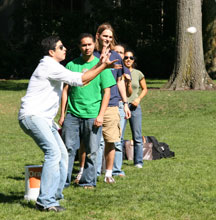 |
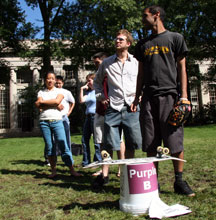 |
 |
During the second run, two laps were completed with only the strongest-armed ball-carriers throwing from each station, still spaced at 50 feet.
The Express rider maintained a speedy 15 mph.
Over-throws and missed catches led to a dramatic finish — with the ball just overtaking the Express rider as he crossed the finish line. |
|
 |
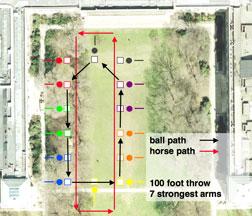
|
The third challenge matched the 100-foot throwing distance assumed in the estimation calculations.
Seven strong throwers threw to every second station and the rider rode his horse as fast as possible, competing over 2 loops around the courtyard. |
Finally, two laps were completed with the 4 strongest arms in the class on the circuit’s corners.
The winded horse struggled to keep pace. |
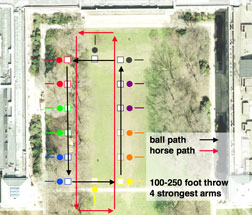 |
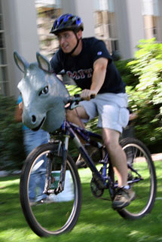 |
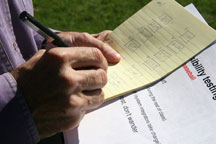 |
The speed of the throwing relay increased with each test as more skilled throwers were used and the distance between throwing stations was increased.
|
Despite suffering from more balls dropped than caught (53% drop rate), the first test still had an average speed of 10.7 mph—just 7% faster than the reported average speed of the Pony Express.
Under the 100 ft throw conditions assumed in the back-of-the-envelope estimate, the predictions were born-out in reality. |
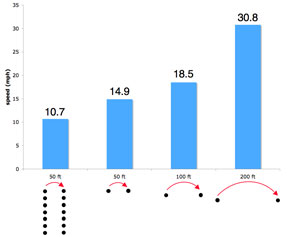 |
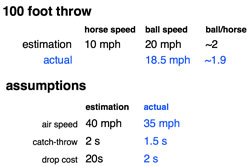 |
We estimated a relay speed of 20 mph and achieved an actual speed of 18.5 mph—an unexpected result given the ball drop rate was 40%.
The average drop recovery was under 2 seconds, 10 times less than allowed for in the estimation.
Our conclusion: myth technically feasible!
(but practically ridiculous) |









